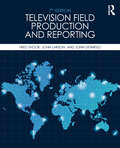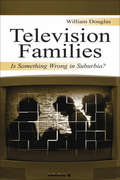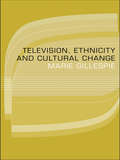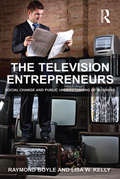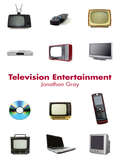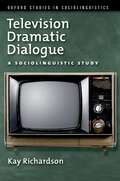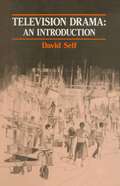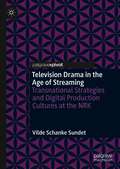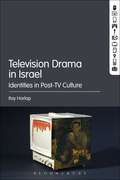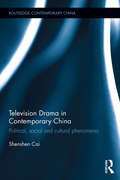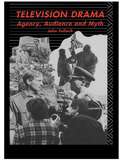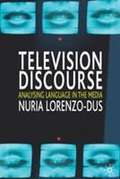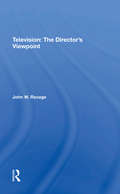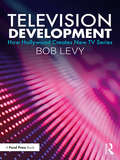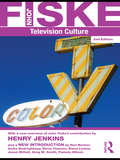- Table View
- List View
Television Field Production and Reporting: A Guide to Visual Storytelling
by Fred Shook John Larson John DeTarsioTelevision Field Production and Reporting provides a comprehensive introduction to the art of video storytelling. Endorsed by the National Press Photographers Association, this book focuses on the many techniques and tools available in today’s digital landscape, including how drones and miniaturized technology can enrich the storytelling process. The new edition of Television Field Production and Reporting is an absolute must in this visually oriented, rapidly changing field. At its core, visual storytelling helps transmit information, expose people to one another, and capture and communicate a sense of experience in unforgettable ways. This edition reflects, through practitioners' eyes, how to achieve those goals and excel as a professional, whatever the medium at hand, even as changing technology revises the storyteller’s toolkit. This edition emphasizes digital and emerging media, and includes new color photography relevant to contemporary visual storytelling and reporting. It also features important updates regarding digital media law which affect anyone who records and/or disseminates digital media content, whether in private, on television, the web, via social networking sites, or in commercial venues. The seventh edition of Television Field Production and Reporting stresses the mastery of innovative storytelling practices in video programming as far ranging as electronic press kits, multi-camera production, stylized programs, corporate video, raw documentaries, and real time cinéma vérité.
Television Field Production and Reporting: A Guide to Visual Storytelling
by Fred Shook John Larson John DeTarsioTelevision Field Production and Reporting provides a comprehensive introduction to the art of video storytelling. Endorsed by the National Press Photographers Association, this book focuses on the many techniques and tools available in today’s digital landscape, including how drones and miniaturized technology can enrich the storytelling process. The new edition of Television Field Production and Reporting is an absolute must in this visually oriented, rapidly changing field. At its core, visual storytelling helps transmit information, expose people to one another, and capture and communicate a sense of experience in unforgettable ways. This edition reflects, through practitioners' eyes, how to achieve those goals and excel as a professional, whatever the medium at hand, even as changing technology revises the storyteller’s toolkit. This edition emphasizes digital and emerging media, and includes new color photography relevant to contemporary visual storytelling and reporting. It also features important updates regarding digital media law which affect anyone who records and/or disseminates digital media content, whether in private, on television, the web, via social networking sites, or in commercial venues. The seventh edition of Television Field Production and Reporting stresses the mastery of innovative storytelling practices in video programming as far ranging as electronic press kits, multi-camera production, stylized programs, corporate video, raw documentaries, and real time cinéma vérité.
Television Families: Is Something Wrong in Suburbia? (Routledge Communication Series)
by William DouglasThis volume examines the analysis that was designed to map the development of the television family and assess its current state and, at the same time, to provide insight into the tangled relationships between fictional and real family life. In order to do this, the investigation examines the evolution of the American family, paying special attention to the postwar family, which is not only used recurrently as a benchmark for assessing the performance of modern families but also constituted television's first generation of families. The investigation also traces the evolution of the popular family in vaudeville, comics, and radio. However, the primary focus of the examination is the development of the television family, from families, such as the Nelsons, Andersons, and Cleavers, to more contemporary families, such as the Huxtables, Conners, and Taylors. The unit of analysis for the investigation is the relationship rather than the individual. Hence, the book deals with the portrayal of spousal, parent-child, and sibling relationships and how those portrayals differ across time and across groups defined by ethnicity, gender, and age. Moreover, the relational analysis is expansive so that television family relationships are examined in regard to power and affect, performance, and satisfaction and stability. Television Families provides a thorough summary and critical review of extant research, designed to promote informed classroom discussion. At the same time, it advances a number of hypotheses and recommendations and, as such, is intended to influence subsequent theory and research in the area. The book is intended for senior undergraduate students, graduate students, and television and family researchers.
Television Families: Is Something Wrong in Suburbia? (Routledge Communication Series)
by William DouglasThis volume examines the analysis that was designed to map the development of the television family and assess its current state and, at the same time, to provide insight into the tangled relationships between fictional and real family life. In order to do this, the investigation examines the evolution of the American family, paying special attention to the postwar family, which is not only used recurrently as a benchmark for assessing the performance of modern families but also constituted television's first generation of families. The investigation also traces the evolution of the popular family in vaudeville, comics, and radio. However, the primary focus of the examination is the development of the television family, from families, such as the Nelsons, Andersons, and Cleavers, to more contemporary families, such as the Huxtables, Conners, and Taylors. The unit of analysis for the investigation is the relationship rather than the individual. Hence, the book deals with the portrayal of spousal, parent-child, and sibling relationships and how those portrayals differ across time and across groups defined by ethnicity, gender, and age. Moreover, the relational analysis is expansive so that television family relationships are examined in regard to power and affect, performance, and satisfaction and stability. Television Families provides a thorough summary and critical review of extant research, designed to promote informed classroom discussion. At the same time, it advances a number of hypotheses and recommendations and, as such, is intended to influence subsequent theory and research in the area. The book is intended for senior undergraduate students, graduate students, and television and family researchers.
Television, Ethnicity and Cultural Change (Comedia)
by Marie GillespieFor 'ethnic minorities' in Britain, broadcast TV provides powerful representations of national and 'western' culture. In Southall - which has the largest population of 'South Asians' outside the Indian sub-continent - the VCR furnishes Hindi films, 'sacred soaps' such as the Mahabharata, and family videos of rites of passage, as well as mainstream American films. Television, Ethnicity and Cultural Change examines how TV and video are being used to recreate cultural traditions within the 'South Asian' diaspora, and how they are also catalysing cultural change in this local community.Marie Gillespie explores how young people negotiate between the parental and peer, local and global, national and international contexts and culturess which traverse their lives. Articulating their own preoccupations with television narratives, they both reaffirm and challenge parental traditions, formulating their own aspirations towards cultural change.Marie Gillespie's in-depth study offers an invaluable survey of how cultures are shaped and changed through people's recreative reception of the media.
Television, Ethnicity and Cultural Change (Comedia)
by Marie GillespieFor 'ethnic minorities' in Britain, broadcast TV provides powerful representations of national and 'western' culture. In Southall - which has the largest population of 'South Asians' outside the Indian sub-continent - the VCR furnishes Hindi films, 'sacred soaps' such as the Mahabharata, and family videos of rites of passage, as well as mainstream American films. Television, Ethnicity and Cultural Change examines how TV and video are being used to recreate cultural traditions within the 'South Asian' diaspora, and how they are also catalysing cultural change in this local community.Marie Gillespie explores how young people negotiate between the parental and peer, local and global, national and international contexts and culturess which traverse their lives. Articulating their own preoccupations with television narratives, they both reaffirm and challenge parental traditions, formulating their own aspirations towards cultural change.Marie Gillespie's in-depth study offers an invaluable survey of how cultures are shaped and changed through people's recreative reception of the media.
The Television Entrepreneurs: Social Change and Public Understanding of Business
by Raymond Boyle Lisa W. KellyWith business seemingly everywhere on television, from the risks of the retail and restaurant trade to pitching for investment or competing to become the next 'apprentice', The Television Entrepreneurs draws upon popular business-oriented shows such as The Apprentice and Dragons' Den to explore the relationship between television and business. Based on extensive interviews with key industry and business figures and drawing on new empirical research into audience perceptions of business, this book examines our changing relationship with entrepreneurship and the role played by television in shaping our understanding of the world of business. The book identifies the key structural shifts in both the television industry and the wider economy that account for these changing representations, whilst examining the extent to which television's developing interest in business and entrepreneurial issues is simply a response to wider social and economic change in society. Does a more commercial and competitive television marketplace, for instance, mean that the medium itself, through a particular focus on drama, entertainment and performance, now plays a key role in re-defining how society frames its engagements with business, finance, entrepreneurship, risk and wealth creation? Mapping the narratives of entrepreneurship constructed by television and analysing the context that produces them, The Television Entrepreneurs investigates how the television audience engages with such programmes and the possible impact these may have on public understanding of the nature of business.
The Television Entrepreneurs: Social Change and Public Understanding of Business
by Raymond Boyle Lisa W. KellyWith business seemingly everywhere on television, from the risks of the retail and restaurant trade to pitching for investment or competing to become the next 'apprentice', The Television Entrepreneurs draws upon popular business-oriented shows such as The Apprentice and Dragons' Den to explore the relationship between television and business. Based on extensive interviews with key industry and business figures and drawing on new empirical research into audience perceptions of business, this book examines our changing relationship with entrepreneurship and the role played by television in shaping our understanding of the world of business. The book identifies the key structural shifts in both the television industry and the wider economy that account for these changing representations, whilst examining the extent to which television's developing interest in business and entrepreneurial issues is simply a response to wider social and economic change in society. Does a more commercial and competitive television marketplace, for instance, mean that the medium itself, through a particular focus on drama, entertainment and performance, now plays a key role in re-defining how society frames its engagements with business, finance, entrepreneurship, risk and wealth creation? Mapping the narratives of entrepreneurship constructed by television and analysing the context that produces them, The Television Entrepreneurs investigates how the television audience engages with such programmes and the possible impact these may have on public understanding of the nature of business.
Television Entertainment (Communication and Society)
by Jonathan GrayTelevision entertainment rules supreme, one of the world’s most important disseminators of information, ideas, and amusement. More than a parade of little figures in a box, it is deeply embedded in everyday life, in how we think, what we think and care about, and who we think and care about it with. But is television entertainment art? Why do so many love it and so many hate or fear it? Does it offer a window to the world, or images of a fake world? How is it political and how does it address us as citizens? What powers does it hold, and what powers do we have over it? Or, for that matter, what is television these days, in an era of rapidly developing technologies, media platforms, and globalization? Written especially for students, Television Entertainment addresses these and other key questions that we regularly ask, or should ask. Jonathan Gray offers a lively and dynamic, thematically based overview with examples from recent and current television, including Lost, reality television, The Sopranos, The Simpsons, political satire, Grey’s Anatomy, The West Wing, soaps, and 24.
Television Entertainment (Communication and Society)
by Jonathan GrayTelevision entertainment rules supreme, one of the world’s most important disseminators of information, ideas, and amusement. More than a parade of little figures in a box, it is deeply embedded in everyday life, in how we think, what we think and care about, and who we think and care about it with. But is television entertainment art? Why do so many love it and so many hate or fear it? Does it offer a window to the world, or images of a fake world? How is it political and how does it address us as citizens? What powers does it hold, and what powers do we have over it? Or, for that matter, what is television these days, in an era of rapidly developing technologies, media platforms, and globalization? Written especially for students, Television Entertainment addresses these and other key questions that we regularly ask, or should ask. Jonathan Gray offers a lively and dynamic, thematically based overview with examples from recent and current television, including Lost, reality television, The Sopranos, The Simpsons, political satire, Grey’s Anatomy, The West Wing, soaps, and 24.
Television Dramatic Dialogue: A Sociolinguistic Study (Oxford Studies in Sociolinguistics)
by Kay RichardsonWhen we watch and listen to actors speaking lines that have been written by someone else-a common experience if we watch any television at all-the illusion of "people talking" is strong. These characters are people like us, but they are also different, products of a dramatic imagination, and the talk they exchange is not quite like ours. Television Dramatic Dialogue examines, from an applied sociolinguistic perspective, and with reference to television, the particular kind of "artificial" talk that we know as dialogue: onscreen/on-mike talk delivered by characters as part of dramatic storytelling in a range of fictional and nonfictional TV genres. As well as trying to identify the place which this kind of language occupies in sociolinguistic space, Richardson seeks to understand the conditions of its production by screenwriters and the conditions of its reception by audiences, offering two case studies, one British (Life on Mars) and one American (House).
Television Drama in the Age of Streaming: Transnational Strategies and Digital Production Cultures at the NRK
by Vilde Schanke SundetThis book examines television drama in the age of streaming—a time when television has been reshaped for national and international consumption via both linear ‘flow’ and on-demand user modes. It builds on an in-depth study of the Norwegian public service broadcaster (NRK) and some of its game-changing drama productions (Lilyhammer, SKAM, blank). The book portrays the formative first decade of television streaming (2010-2019), how new streaming services and incumbent television providers intersect and act in a new drama landscape, and how streaming impacts existing television production cultures, publishing models and industry-audience relations. The analysis draws on insight gained through more than a hundred interviews with television experts and fans, hundreds of hours of observations, and unique access to industry conferences, meetings, working documents, and ratings. The book combines perspectives from production studies, media industry studies, and fan studies to inform its analysis.
Television Drama in Israel: Identities in Post-TV Culture
by Itay HarlapIsraeli television, currently celebrating fifty years of broadcasting, has become one of the most important content sources on the international TV drama market, when serials such as Homeland, Hostages, Fauda, Zaguory Empire and In Treatment were bought by international networks, HBO included. Offering both a textual reading and discourse analysis of contemporary Israeli television dramas, Itay Harlap adopts a case study approach in order to address production, reception and technological developments in its accounts. His premise is that the meeting point between social trends within Israeli society (primarily the rise of opposition groups to the hegemony of the Zionist-Jewish-masculine-Ashkenazi ideologies) and major changes in the medium in Israel (which are comparable to international changes that have been titled "post-TV"), led to the creation of television dramas characterized by controversial themes and complex narratives, which present identities in ways never seen before on television or in other Israeli mediums.
Television Drama in Israel: Identities in Post-TV Culture
by Itay HarlapIsraeli television, currently celebrating fifty years of broadcasting, has become one of the most important content sources on the international TV drama market, when serials such as Homeland, Hostages, Fauda, Zaguory Empire and In Treatment were bought by international networks, HBO included. Offering both a textual reading and discourse analysis of contemporary Israeli television dramas, Itay Harlap adopts a case study approach in order to address production, reception and technological developments in its accounts. His premise is that the meeting point between social trends within Israeli society (primarily the rise of opposition groups to the hegemony of the Zionist-Jewish-masculine-Ashkenazi ideologies) and major changes in the medium in Israel (which are comparable to international changes that have been titled "post-TV"), led to the creation of television dramas characterized by controversial themes and complex narratives, which present identities in ways never seen before on television or in other Israeli mediums.
Television Drama in Contemporary China: Political, social and cultural phenomena (Routledge Contemporary China Series)
by Shenshen CaiDue to high audience numbers and the significant influence upon the opinions and values of viewers, the political leadership in China attributes great importance to the impact of television dramas. Many successful TV serials have served as useful conduits to disseminate official rhetoric and mainstream ideology, and they also offer a rich area of research by providing insight into the changing Chinese political, social and cultural context. This book examines a group of recently released TV drama serials in China which focus upon, and to various degrees represent, topical political, social and cultural phenomena. Some of the selected TV serials reflect the present ideological proclivities of the Chinese government, whilst others mirror social and cultural occurrences or provide coded and thought-provoking messages on China’s socio-economic and political reality. Through in-depth textual analysis of the plots, scenes and characters of these selected TV serials, the book provides timely interpretations of contemporary Chinese society, its political inclinations, social fashions and cultural tendencies. The book also demonstrates how popular media narratives of TV drama serials engage with sensitive civic issues and cultural phenomena of modern-day China, which in turn encourages a broader social imagination and potential for change. Advancing our understanding of contemporary China, this book will appeal to students and scholars of contemporary Chinese culture, society and politics, as well as those with research interests in television studies more generally.
Television Drama in Contemporary China: Political, social and cultural phenomena (Routledge Contemporary China Series)
by Shenshen CaiDue to high audience numbers and the significant influence upon the opinions and values of viewers, the political leadership in China attributes great importance to the impact of television dramas. Many successful TV serials have served as useful conduits to disseminate official rhetoric and mainstream ideology, and they also offer a rich area of research by providing insight into the changing Chinese political, social and cultural context. This book examines a group of recently released TV drama serials in China which focus upon, and to various degrees represent, topical political, social and cultural phenomena. Some of the selected TV serials reflect the present ideological proclivities of the Chinese government, whilst others mirror social and cultural occurrences or provide coded and thought-provoking messages on China’s socio-economic and political reality. Through in-depth textual analysis of the plots, scenes and characters of these selected TV serials, the book provides timely interpretations of contemporary Chinese society, its political inclinations, social fashions and cultural tendencies. The book also demonstrates how popular media narratives of TV drama serials engage with sensitive civic issues and cultural phenomena of modern-day China, which in turn encourages a broader social imagination and potential for change. Advancing our understanding of contemporary China, this book will appeal to students and scholars of contemporary Chinese culture, society and politics, as well as those with research interests in television studies more generally.
Television Drama: Agency, Audience and Myth (Studies in Culture and Communication)
by John TullochFirst published in 1990. Routledge is an imprint of Taylor & Francis, an informa company.
Television Drama: Agency, Audience and Myth (Studies in Culture and Communication)
by John TullochFirst published in 1990. Routledge is an imprint of Taylor & Francis, an informa company.
Television Discourse: Analysing Language In The Media (PDF)
by Nuria Lorenzo-DusWhat is the connection between what is said on TV and how it is said? Structured around key features of television discourse, Nuria Lorenzo-Dus examines the specific forms and structures of talk across media genres. Using data from programs as varied as news bulletins and political speeches to makeover and talk shows,Television Discourse examines four defining characteristics of the current broadcast landscape: Storytelling, Closeness, Conflict and Persuasion. This innovative, four-part structure allows for detailed discourse analysis of how each feature works in context; whilst 'Storytelling' is examined in relation to docu-soaps and talk shows, 'Closeness' is explored through the mediums of celebrity chat shows and reality programming. Insightful analysis of 'Conflict' in courtroom shows and 'Persuasion' in lifestyle programs enables readers to think critically about the ways in which television discourse is used to influence the viewer. With a helpful glossary and extensive guide to further reading,Television Discourse is an invaluable resource for all those interested in studying language in the media.
Television: The Director's Viewpoint
by John W. Ravage Jack RavageTelevision directors remain an enigma to most students of the mass media; traditionally, their function has been little understood by scholars and the viewing public. In this book, John Ravage studies the role of the director in the producer-dominated medium of commercial television. Built around lengthy interviews with twelve of the leading directors of commercial programs—representing all the genres of "prime time"—the book analyzes the major issues facing television, its past, present, and portents for the future, and the audience that watches it.
Television: The Director's Viewpoint
by John W. Ravage Jack RavageTelevision directors remain an enigma to most students of the mass media; traditionally, their function has been little understood by scholars and the viewing public. In this book, John Ravage studies the role of the director in the producer-dominated medium of commercial television. Built around lengthy interviews with twelve of the leading directors of commercial programs—representing all the genres of "prime time"—the book analyzes the major issues facing television, its past, present, and portents for the future, and the audience that watches it.
Television Development: How Hollywood Creates New TV Series
by Bob LevyDevelopment is a large and central part of the American TV industry, and yet the details of how it works – who makes development decisions and why, where ideas for new shows come from, even basics like the differences between what TV studios and TV networks do – remain elusive to many. In this book, lecturer and acclaimed television producer Bob Levy offers a detailed introduction to television development, the process by which the Hollywood TV industry creates new scripted series. Written both for students and industry professionals, Television Development serves as a comprehensive introduction to all facets of the development process: the terminology, timelines, personnel and industrial processes that take a new TV project from idea to pitch to script to pilot to series. In addition to describing these processes, Levy also examines creative strategies for successful development, and teaches readers how to apply these strategies to their own careers and speak the language of development across all forms of visual storytelling. Written by the renowned producer responsible for developing and executive producing Gossip Girl and Pretty Little Liars, Television Development is an essential starting point for students, executives, agents, producers, directors and writers to learn how new series are created. Accompanying online material includes sample pitches, pilot scripts, and other development documents.
Television Development: How Hollywood Creates New TV Series
by Bob LevyDevelopment is a large and central part of the American TV industry, and yet the details of how it works – who makes development decisions and why, where ideas for new shows come from, even basics like the differences between what TV studios and TV networks do – remain elusive to many. In this book, lecturer and acclaimed television producer Bob Levy offers a detailed introduction to television development, the process by which the Hollywood TV industry creates new scripted series. Written both for students and industry professionals, Television Development serves as a comprehensive introduction to all facets of the development process: the terminology, timelines, personnel and industrial processes that take a new TV project from idea to pitch to script to pilot to series. In addition to describing these processes, Levy also examines creative strategies for successful development, and teaches readers how to apply these strategies to their own careers and speak the language of development across all forms of visual storytelling. Written by the renowned producer responsible for developing and executive producing Gossip Girl and Pretty Little Liars, Television Development is an essential starting point for students, executives, agents, producers, directors and writers to learn how new series are created. Accompanying online material includes sample pitches, pilot scripts, and other development documents.
Television Culture
by John FiskeThis revised edition of a now classic text includes a new introduction by Henry Jenkins, explaining ‘Why Fiske Still Matters’ for today’s students, followed by a discussion between former Fiske students Ron Becker, Aniko Bodroghkozy, Steve Classen, Elana Levine, Jason Mittell, Greg Smith and Pam Wilson on ‘John Fiske and Television Culture’. Both underline the continuing relevance of this foundational text in the study of contemporary media and popular culture. Television is unique in its ability to produce so much pleasure and so many meanings for such a wide variety of people. In this book, John Fiske looks at television’s role as an agent of popular culture, and goes on to consider the relationship between this cultural dimension and television’s status as a commodity of the cultural industries that are deeply inscribed with capitalism. He makes use of detailed textual analysis and audience studies to show how television is absorbed into social experience, and thus made into popular culture. Audiences, Fiske argues, are productive, discriminating, and televisually literate. Television Culture provides a comprehensive introduction for students to an integral topic on all communication and media studies courses.
